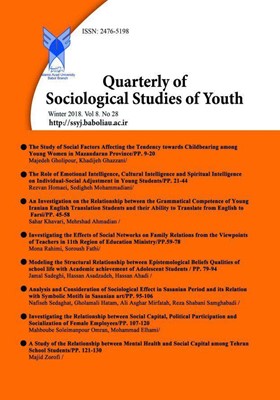An Investigation on the Relationship between the Grammatical Competence of Young Iranian English Translation Students and their Ability to Translate from English to Farsi
محورهای موضوعی :Sahar Khavari 1 , Mehrshad Ahamadian 2
1 - Department of TEFL, Qaemshahr Branch, Islamic Azad University, Qaemshahr, Iran
2 - Department of TEFL, Qaemshahr Branch, Islamic Azad University, Qaemshahr, Iran
کلید واژه: Translation ability, Grammatical competence, Young English translation students,
چکیده مقاله :
Today, everything has changed and this has brought a need for learning a second language. Most countries across the world use English as their second/foreign language and the fundamental part of this process is grammar, i.e., the combination of sound, structure, and meaning system of language. A sentence can be composed of several words, clauses, as well as grammatical rules. These grammatical rules should be learned efficiently as they may make a sentence meaningfully different. Hence, the main concern of this study was to find out whether there was any relationship between the grammatical competence and translation ability. To this end, the OPT and translation tests were administrated to 64 young students who studied English translation at Islamic Azad University (Qaemshahr branch). The findings showed that the correlation coefficient between OPT and translation scores was .92 at significance value of P≤.01, which implies a high level of reliability. The results showed a positive relationship between the grammatical competence and translation ability; in other words, those with higher OPT score demonstrate better on translation test than the others.
10. Munday, J. (2001). Introducing translation studies: theories and application. London: Routledge.
11. Nassaji, H., & Swain, M. (2000). A Vygotskian perspective on corrective feedback in L2: The effect of random versus negotiated help on the learning of English articles. Language Awareness, 9(1), 34-51.
12. Nassaji, H., & Swain, M. (2000). A Vygotskian perspective on corrective feedback in L2: The effect of random versus negotiated help on the learning of English articles. Language Awareness, 9(1), 34-51.
13. Nassaji, H. & Fotos , S. (2011).Teaching grammar in second language classrooms: Integrating form-focused instruction in communicative context. New York: Routledge.
14. Nassaji, H.,& Fotos, S. (2011). Teaching grammar in second language classrooms: Integrating form-focused instruction in communicative context. New York: Routledge.
15. Newmark, P. (1988). A text book of translation. New York : Prentice Hall.
16. Nida, E.A. (1976). A framework for the analysis and evaluation of theories of translation. In R. Brislin (Ed.), Translation: Applications and research (pp. 47- 91). New York: Gardner Press.
17. PACTE (2005). Investigating translation competence: Conceptual and Methodological Issues, Meta, 50 (2), 609-618.
18. Richards, J.& Renandya, W.(2002). Methodology in language teaching: An anthology of current practice. Cambridge. United Kingdom: Cambridge University Press.
19. Rose, K.R., & Kasper, G. (2001). Pragmatics in language teaching. New York: Cambridge University Press.
20. Sakurai, N. (2015).The influence of translation on reading amount, proficiency, and speed in extensive reading. Reading in a Foreign Language. 27(1), 96-112.
21. Timmis, I. (2012). Spoken language research and ELT: Where are we now? ELT Journal, 66(4), 514-522.
22. Venuti, L. (1995).The translator's invisibility: A history of translation. London: Routledge.


